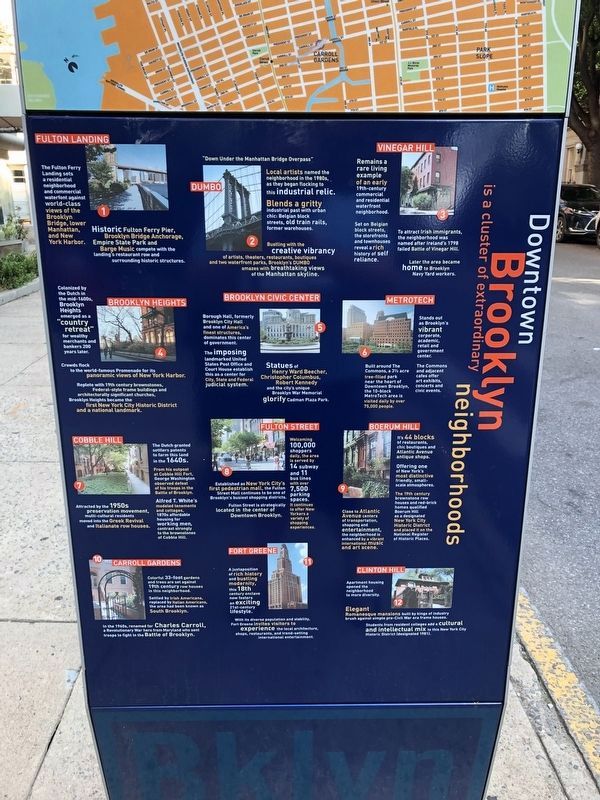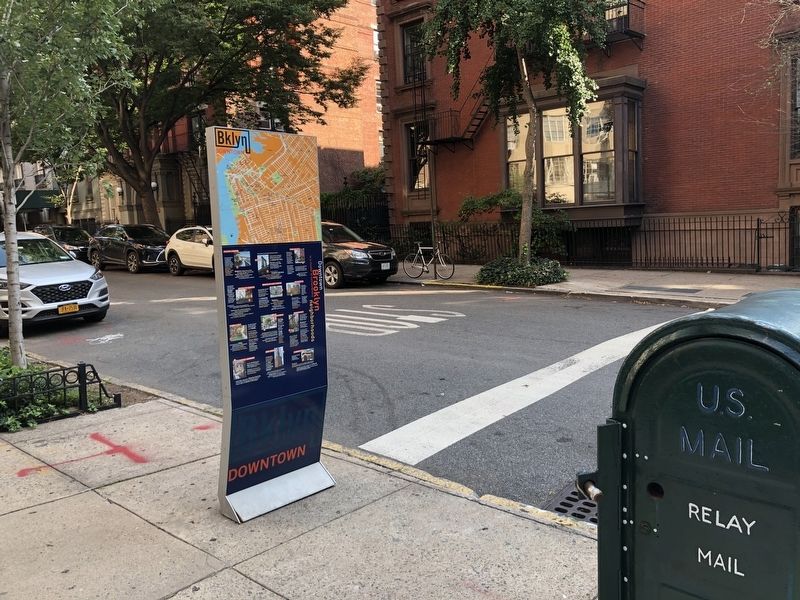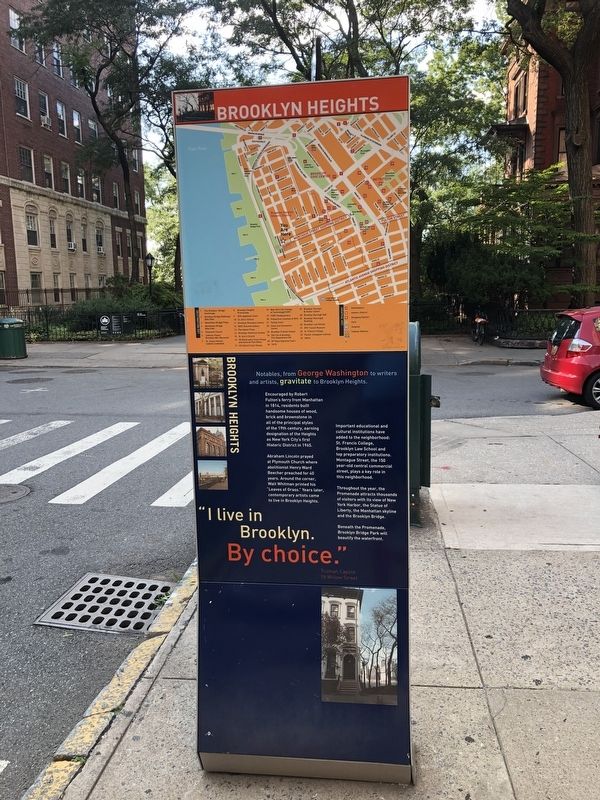Brooklyn Heights in Kings County, New York — The American Northeast (Mid-Atlantic)
Brooklyn Heights / Downtown Brooklyn
Brooklyn Heights
Notables, from George Washington to writers and artists, gravitate to Brooklyn Heights.
Encouraged by Robert Fulton's ferry from Manhattan in 1814, residents built handsome houses of wood, brick and brownstone in all of the principal styles of the 19th century, earning designation of the Heights as New York City's first Historic District in 1965.
Abraham Lincoln prayed at Plymouth Church where abolitionist Henry Ward Beecher preached for 40 years. Around the corner, Walt Whitman printed his "Leaves of Grass." Years later, contemporary artists came to live in Brooklyn Heights.
Important educational and cultural institutions have added to the neighborhood: St. Francis College, Brooklyn Law School and top preparatory institutions. Montague Street, the 150 year-old central commercial street, plays a key role in this neighborhood.
Throughout the year, the Promenade attracts thousands of visitors with its view of New York Harbor, the Statue of Liberty, the Manhattan skyline and the Brooklyn Bridge.
Beneath the Promenade, Brooklyn Bridge Park will beautify the waterfront.
"I live in Brooklyn. By choice."
Truman Capote
70 Willow Street
Downtown Brooklyn
is a cluster of extraordinary neighborhoods
1. Fulton Landing
The Fulton Ferry Landing sets a residential neighborhood and commercial waterfront against world-class views of the Brooklyn Bridge, lower Manhattan, and New York Harbor.
Historic Fulton Ferry Pier, Brooklyn Bridge Anchorage, Empire State Park and Barge Music compete with the landing's restaurant row and surrounding historic structures.
2. DUMBO
"Down Under the Manhattan Bridge Overpass"
Local artists named the neighborhood in the 1980s, as they began flocking to this industrial relic.
Blends a gritty industrial past with urban chic: Belgian block streets, old train rails, former warehouses.
Bustling with the creative vibrancy of artists, theaters, restaurants, boutiques and two waterfront parks, Brooklyn's DUMBO amazes with breathtaking views of the Manhattan skyline.
4. Vinegar Hill
Remains a rare living example of an early 19th-century commercial and residential waterfront neighborhood.
Set on Belgian block streets, the storefonts and townhouses reveal a rich history of self-reliance.
To attract Irish immigrants, the neighborhood was named after Ireland's 1798 failed Battle of Vinegar Hill.
Later the area became home to Brooklyn Navy Yard workers.
4. Brooklyn Heights
Colonized

Photographed By Devry Becker Jones (CC0), September 10, 2021
2. Downtown Brooklyn side of the marker
Crowds flock to the world-famous Promenade for its panoramic views of New York Harbor.
Replete with 19th century brownstones, Federal-style frame buildings and architecturally significant churches, Brooklyn Heights became the first New York City Historic District and a national landmark.
5. Brooklyn Civic Center
Brooklyn Hall, formerly Brooklyn City Hall and one of America's finest structures, dominates this center of government.
The imposing landmarked United States Post Office and Court House establish this as a center for City, State and Federal judicial system.
Statues of Henry Ward Beecher, Christopher Columbus, Robert Kennedy and the city's unique Brooklyn War Memorial glorify Cadman Plaza Park.
6. MetroTech
Stands out as Brooklyn's vibrant corporate, academic, retail and government center.
The Commons and adjacent cafes offer art exhibits, concerts and civic events.
Built around The Commons, a 3˝ acre tree-filled park near the heart of Downtown Brooklyn, the 10-block MetroTech area is visited daily by over 75,000 people.
7. Cobble Hill
The Dutch granted settlers patents to farm this land in the 1640s.
From

Photographed By Devry Becker Jones (CC0), September 10, 2021
3. Brooklyn Heights / Downtown Brooklyn Marker
Alfred T. White's modeled tenements and cottages, 1870s affordable housing for working men, contrast strongly to the brownstones of Cobble Hill.
Attracted by the 1950s preservation movements, multi-cultural residents moved into the Greek Revival and Italianate row houses.
8. Fulton Street
Welcoming 100,000 shoppers daily, the area is served by 14 subway and 11 bus lines with over 7,500 parking spaces. It continues to offer New Yorkers a variety of shopping experiences.
Established as New York City's first pedestrian mall, the Fulton Street Mall continues to be one of Brooklyn's busiest Shopping districts.
Fulton Street is strategically located in the center of Downtown Brooklyn.
9. Boerum Hill
It's 44 block of restaurants, chic boutiques and Atlantic Avenue antique shops.
Offering one of New York's most distinctive friendly, small-scale atmospheres.
The 19th century brownstone row houses and red-brick homes qualified Boerum Hill as a designated New York City Historic District and placed it on the National Register of Historic Places.
Close to Atlantic Avenue centers of transportation, shopping and entertainment, the neighborhood is enhanced by a vibrant international music and art scene.
10. Carroll Gardens
Colorful 33-foot gardens and trees are set against 19th century row houses in this neighborhood.
Settled by Irish Americans, replaced by Italian Americans, the area had been known as South Brooklyn.
In the 1960s, renamed for Charles Carroll, a Revolutionary War hero from Maryland who sent troops to fight in the Battle of Brooklyn.
11. Fort Greene
A juxtaposition of rich history and bustling modernity, this 18th century enclave now fosters an exciting 21st-century lifestyle.
With its diverse population and stability, Fort Green invites visitors to experience the local architecture, shops, restaurants, and trend-setting international entertainment.
12. Clinton Hill
Elegant Romanesque mansions built by kings of industry brush against simple pre-Civil War era frame houses.
Students from resident colleges add a cultural and intellectual mix to this New York City Historic District (designated 1981).
Apartment housing opened the neighborhood to more diversity.
Erected by Downtown Brooklyn. (Marker Number 4.)
Topics and series. This historical marker is listed in these topic lists: Architecture • Churches & Religion • Industry & Commerce • Settlements & Settlers. In addition, it is included in the Former U.S. Presidents: #01 George Washington, and the Former U.S. Presidents: #16 Abraham Lincoln series lists. A significant historical year for this entry is 1814.
Location. 40° 41.741′ N, 73° 59.836′ W. Marker is in Brooklyn, New York, in Kings County. It is in Brooklyn Heights. Marker is at the intersection of Montague Street and Pierrepont Place, on the right when traveling west on Montague Street. Touch for map. Marker is at or near this postal address: 50 Montague St, Brooklyn NY 11201, United States of America. Touch for directions.
Other nearby markers. At least 8 other markers are within walking distance of this marker. W.H. Auden (within shouting distance of this marker); Arthur Miller (within shouting distance of this marker); Thomas Wolfe (within shouting distance of this marker); Four Chimneys (within shouting distance of this marker); 155 - 157 - 159 Willow Street (about 400 feet away, measured in a direct line); History in the Park (about 500 feet away); Henry Miller (approx. 0.2 miles away); Garden Place (approx. 0.2 miles away). Touch for a list and map of all markers in Brooklyn.
Credits. This page was last revised on January 31, 2023. It was originally submitted on September 11, 2021, by Devry Becker Jones of Washington, District of Columbia. This page has been viewed 246 times since then and 21 times this year. Last updated on September 11, 2021, by Bradley Owen of Morgantown, West Virginia. Photos: 1, 2, 3. submitted on September 11, 2021, by Devry Becker Jones of Washington, District of Columbia.
